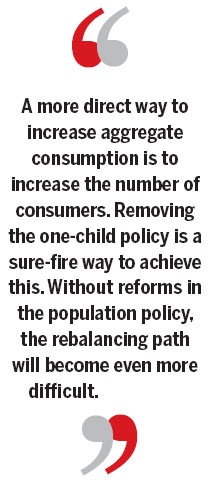Time to review family planning policy
Updated: 2012-06-15 12:40
By Chris Leung (China Daily)
|
|||||||||||
China's family planning policy has been in place since 1979. It was implemented primarily out of economic considerations. Although enforcement is generally strict in urban areas, rural families are allowed to have a second child if the first is a girl, and some ethnic groups are exempted from the policy.
 |
More recently, areas such as Beijing and Henan have relaxed the restrictions by allowing two parents who are an only child themselves to have a second child.
In the plenary sessions of the annual Chinese People's Political Consultative Conference and the National People's Congress in 2011, suggestions supporting a two-child policy were raised. The government, however, was adamant that the one-child policy should remain intact, until at least 2015.
The changing economic landscape, however, suggests an imminent need to review the one-child policy - the sooner the better. The primary mandate under the 12th Five-Year Plan (2011-15) is to boost private consumption. Strangely, this goal was not accompanied by discussions about demography. With the savings rate exceeding 50 percent of GDP, despite faster wage increases in recent years, efforts to boost consumption have reaped little success so far. Rising wages, alongside reforms in the healthcare and pension systems, at best raised consumption per head.
A more direct way to increase aggregate consumption is to increase the number of consumers. Removing the one-child policy is a sure-fire way to achieve this. Without pre-emptive reforms in the population policy, the rebalancing path will become even more difficult when aging eventually kicks in.
On the supply side, the peak in China's working population will arrive in just three years time. According to the United Nations, the one-child policy will cut the number of 15 to 24-year-olds, the lynchpin of factories, by 27 percent to 164 million by 2025. It takes at least 16 years for children conceived today to enter the labor force. Even if authorities relax policy today, it will not make a positive impact on the young workforce until at least 2028.
Benefits in the longer term should be apparent and pronounced. Increasing the fertility rate to 2.3 children per woman from the present 1.6 - well below the replacement rate of 2.1 - would cut the expected decline in the workforce by 2050 to 8.8 percent from 17.3 percent. If authorities do not act soon, overall productivity will eventually decline with fewer young workers. Already, labor costs have on average increased faster than labor productivity since 2005. A slowdown of productivity growth will undermine China's cost competitiveness.
The old-age dependency ratio will increase in a straight line after 2010. Between 2000 and 2010, the ratio was pretty constant. But it is the slope of the black line that shows the gist of the problem - the burden of having to support retirees will accelerate with time.
To better grasp the reality of the problem, take a look at Japan. Due to aging, Japan's productivity has slowed, partially explaining the lower growth rates over the recent decade. If the one-child policy is not relaxed soon, China's population structure in 2050 may resemble that of Japan's today, which has grave implications on future economic growth.
Finally, an aging population also puts pressure on the healthcare and pension systems. According to the UN, pension and healthcare costs will soar as those over the age of 65 surge 78 percent to 196 million by 2025. In the private sector, the young and able will opt to increase precautionary savings to insure against uncertainty as they anticipate increasing pressures on public services, working against the objectives of rebalancing.
The state will face the immediate challenge of surging public spending on education at the local government level. The obstetrics and pediatrics sections of hospitals may be overwhelmed if preparations are inadequate.
A somewhat different concern is that as most people covered in the existing policy are urbanites, the high costs of living may cap the potential increase in fertility rates even when the policy is removed. If home ownership remains out of reach for many, the incentive to have more children will be lessened, particularly for middle-income households.
In Shanghai, the house price-to-income ratio is 30.4 in 2012, meaning it takes a family of two wage earners 30.4 years of income to purchase a home. In Hong Kong, where the price-to- income ratio is slightly higher at 30.7, fertility rates were only 0.99 over 2005-2010, even without restrictions on childbirth.
Measures to address these socioeconomic issues must go hand in hand with changes in the one-child policy, otherwise China's demographic problems will remain.
The eventual success of China's rebalancing is thus not only a positive function of conventional growth parameters, but also a function of how authorities relax the one-child policy while simultaneously introducing reforms in other social sectors.
Given that China has already made up its mind to opt for a growth model premised on domestic demand, relaxing the one-child policy is only a matter of time. Preparation work for the eventual course reversal in the one-child policy may have already begun, as evidenced by increased emphasis on education and medical care in Premier Wen Jiabao's latest comments at the National People's Congress.
The author is a senior economist at DBS Bank (Hong Kong). The views do not necessarily reflect those of China Daily.
(China Daily 06/15/2012 page10)
Today's Top News
Rescuers race against time for quake victims
Telecom workers restore links
Coal mine blast kills 18 in Jilin
Intl scholarship puts China on the map
More bird flu patients discharged
Gold loses sheen, but still a safe bet
US 'turns blind eye to human rights'
Telecom workers restore links
Hot Topics
Lunar probe , China growth forecasts, Emission rules get tougher, China seen through 'colored lens', International board,
Editor's Picks

|

|

|

|

|

|





